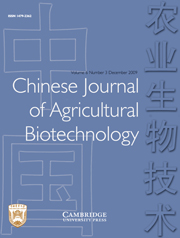Article contents
Diversity of endophytic diazotrophs isolated from Bambusa blumeana in Guangdong province
Published online by Cambridge University Press: 02 August 2007
Abstract
Endophytic bacteria isolated from Guangdong bamboo (Bambusa blumeana) plants were obtained under aerobic and anaerobic cultural conditions. Using the acetylene reduction assay (ARA), 40 strains were identified as diazotrophs. Diazotrophic isolates were grouped into five clusters (I, II, III, IV and V) by SDS-PAGE whole-cell protein patterns. The analysis of full-length 16S rDNA sequences of the representative strains of each group indicated that the endophytic diazotrophs showed great diversity and belonged to the genera Azospirillum (α-subclass of proteobacteria), Escherichia and Pseudomonas (γ-subclass of proteobacteria), and Aquaspirillum (β-subclass of proteobacteria).
- Type
- Research Article
- Information
- Copyright
- Copyright © China Agricultural University and Cambridge University Press 2007
Footnotes
First published in Journal of Agricultural Biotechnology 2007, 15(2): 290–294
References
- 3
- Cited by


